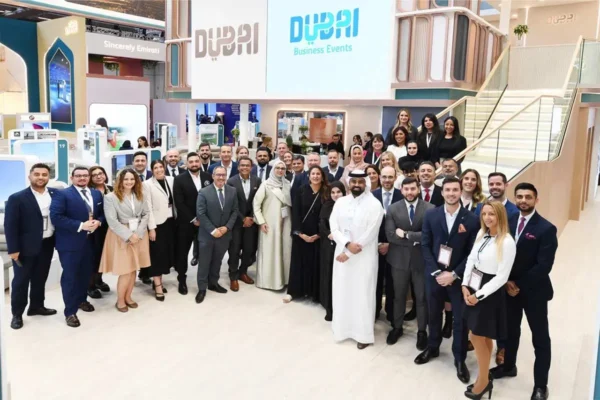Combining science with art, carpet manufacturing creates a functional masterpiece seen on almost every show floor in the U.S. Located in the heart of the “Carpet Capital of the World” is Beaulieu of America, a family owned and operated manufacturer of carpet for residential, commercial and tradeshows.
From the raw material to the finished product, Beaulieu has produced and controlled every aspect of carpet-making at its 19 vertically integrated facilities in and around Dalton, Ga., since investing in yarn extrusion in 1981.
“We are fully integrated in-house. For example, with nylon, we take the chemicals, we make the chip, we extrude the chip into yarn, we cable and heat set the yarn, do the tufting, dyeing and coating. So we really have the expertise to control everything that goes on in the making of carpet,” said Mike Amburgey, chief marketing officer, Beaulieu.
FIBER & YARN PRODUCTION
At its Bridgeport, Ala., polymer plant is where Beaulieu creates its own Nylon 6 and other yarns.
A variety of fibers are produced at Beaulieu including polyester converted from waste plastic, such as water bottles. While the plastic products produce stain-resistant and pliable fiber, the majority of carpets manufactured are made from nylon.
“Quality with us starts with the yarn. Right from the resin,” said Bob Lee, executive vice president of sales, Beaulieu.
Chosen for its impressive qualities, Nylon 6 boasts protection from light degradation, dyeability, elastic recovery, fatigue resistance and thermal stability.
Caprolactam, from which Nylon 6 is produced, can solidify before being transferred into the Beaulieu facility. To keep the liquid form of caprolactum from hardening, it is placed in a chamber surrounded by steam as the “capro” is being pumped. Polymerization converts liquid caprolactum into nylon chips, which are then turned into flat nylon yarn, a process costing millions of dollars.
“Until we get to an actual fiber on a spool, there’s no actual contact with the material by hand,” explained Justin Carpenter, plant manager, Beaulieu.
Reactors that generate high heat mix the caprolactum with water and an acid called “The Terminator” to form Nylon 6. Beaulieu uses three reactors to force the molten compound through a 30-hole spinneret, shaping the nylon into strands. Drenched in cold water, the strands are solidified in a process called quenching, one of the few processes that is performed in the open and can be visibly seen. Placed into a pelletizer, the strands are chopped into smaller chips by sharp blades. Washed of impurities and baked to dry, the resulting chips make pure Nylon 6.
In an effort to be eco-friendly, technologies in place at the Beaulieu facility recover waste materials and reuse them.
“We’re concerned about the environment, that’s why we put in safeguards here to ensure that we are converting all the material into a reusable end product,” said Lee.
Half of the Nylon 6 is solution-dyed, which means the pigment chips and natural chip are extruded together. In processing chambers, both chips are melted and fed through spinnerets, emerging as solid strands of yarn. Spinnerets determine the thickness and shape of the strands. Beaulieu typically creates triangular-shaped holes to produce tri-lobal threads that better diffuse light than round strands, lessening the visibility of soil and adding a look of sparkle to the final product.
After it’s been shaped, the fibers go through another quenching process to be wound on a hot roll. To create a greater tenacity in the fibers, they are drawn and stretched through a winder. The yarn is then textured by hot air for easier handling.
Carpet fiber strength and appearance depend on the fiber twisting or cabling process. Two strands of fiber are twisted together up to six times. Twisted yarn accumulates on a spool called the package. Approximately 4,000 packages of twisted yarn are prepped daily for the final process of heat-setting. To permanently set the fiber, two different types of heat are used – dry heat generated by electricity in ovens used for solution-dyed fiber, and steam to open the pores of undyed fiber for future dyeing.
Determining the proper heat-setting method depends on the desired type of carpet. The resulting product is considered finished yarn.
MANUFACTURING
Two layers of backing – primary and secondary – are needed to manufacture carpet. Using polypropylene slit film, a sturdy yarn consisting of up to 2,000 thin strands, the primary backing is woven both length-wise and width-wise.
As the support system for the tufting process, this primary backing is tightly woven. Less dense than the primary, the secondary backing, made for dimensional stability, is produced much faster. As such, only one-third of Beaulieu’s machinery to manufacture backing is dedicated to secondary backing.
TUFTING
“Tufting is a term that comes from the old days of making chenille bedspreads,” Lee stated. “It is the process of sewing fiber into a primary backing and creating a plush face.”
Dubbed the “Carpet Capital of the World,” entrepreneurs in Dalton, Ga., discovered that while yarn can be stitched through a cotton bedspread to create chenille, stitching yarn through a different type of backing creates carpet. The discovery led to an emergence of carpet manufacturing in and around this small Southern city, located just one hour outside of Atlanta.
Carpet is tufted from underneath and directly into one yard of primary backing then bonded with a sturdier, second yard of secondary backing.
A tufter does the handiwork by pulling thread from a creel containing spools of yarn. A fiber strand is air suctioned into the back of the tufting machine where each strand is fed and threaded through a needle. Costing from $500,000 to $1.5 million per tufter.
The number of needles needed depends on the number of tufts per square inch of carpet. A tenth-gauge carpet would require 10 needles per horizontal inch; therefore, for a 12-foot carpet, 1,440 needles are needed.
Imperfections in the tufting are removed from the carpet by hand by operators who perform quality control and also repair the fabric when a yarn breaks.
DYE LINE
Kusters, German-made machines designed to dye tufted carpet, can change between different colors or fabrics instantaneously. The process begins with a prewash followed by an even application of the selected dye when moved under dye heads. In an average of eight minutes, the dye is set by a steamer. While damp and still permeable, stain blocker and fluorine treatments are topically added before the carpet is placed in an oven to be dried.
Operators using InstaColor are able to change dye colors without slowing the pace of the machine.
“The InstaColor will change colors within three inches. It will change from one color to the next strictly by changing the concentration of yellow, red or blue,” said Scott Williams, quality assurance manager, Beaulieu.
Inspected for color issues, the dried carpet is evaluated both by the human eye and a spectrometer that compares between the colors on the sides and in the center to ensure no difference in shading.
COATING
Depending on the carpet style, about 20 ounces of latex per square yard coats the secondary backing before it is bonded to the primary backing. Maintaining the proper temperature control is critical to the bonding process between the primary and secondary backings.
SHEARING, FINAL INSPECTION & PACKAGING
Shearing is the final process in carpet manufacturing when blades reduce the carpet to a specific pile height. Suctions collect the excess fibers, which are later sold to pavement companies to be used as a bonding agent in asphalt.
Final inspection includes half a dozen points of quality control. Taking six hours to inspect and package, only first grade finished carpet that has passed inspection leave the facility to be used as floor covering.
DISTRIBUTION
Operating three Distribution Centers across the U.S., Beaulieu has facilities in Georgia, New Jersey and California.
A majority of its orders are fulfilled within 24 hours, according to Bob Lee.
“In our Dalton Distribution Center, we have 1.5 million square feet of space, 126 dock doors, over 100 Hysters and several thousand feet of conveyors. Everything is barcoded, everything is scanned and everything is driven through computer automation,” said Lee.
Spanning the length of nine football fields, the conveyor moves rolls of carpet through the facility where a laser scanner determines the closest point of travel to the truck awaiting its delivery.
CARPET TRADESHOWS
FloorTek Expo
Dedicated to carpet manufacturers is FloorTek Expo, a tradeshow for the floor covering and textile industry. Started in 1994 by the American Flooring Alliance, the show became a biannual tradition and the only one to be held in Dalton, Ga.
Over 2.5 days, approximately 100 exhibitors showcase the latest technological advances in carpet manufacturing machinery and equipment. Primarily manufacturers, thousands of industry members are invited to attend the tradeshow.
In its fifth year, tragedy struck on the show’s opening day on Sept. 11, 2001. Following the terrorist attack and subsequent economic recession, FloorTek Expo has cancelled a number of shows, last exhibiting in September 2013.
“There aren’t enough changes in the machinery to warrant a show every year,” shared Wanda Ellis, executive director, American Flooring Alliance.
For over 15 years, Ellis works with both producers of carpet machinery and carpet manufacturers to exhibit their wares both domestically and internationally.
After September 2013, Ellis saw a rise in printing technology and the ability to print images and styles on different types of yarn.
Basing its show on the economic climate, technological developments in carpet machinery, and overall demand from exhibitors and attendees, the show will next be held in 2016.
Surfaces
While there are a number of smaller regional tradeshows dedicated to carpet flooring and manufacturing, the largest single tradeshow currently is Surfaces, which occurs in late January in Las Vegas. In 2014, there will be a second Surfaces show in Miami Beach, Fla.
Also this year, SURFACES and StonExpo/Marmomacc Americas co-launched TileExpo in Las Vegas and TileExpo East for Miami Beach attendees in October, an event dedicated to flooring, stone and tile professionals.





























